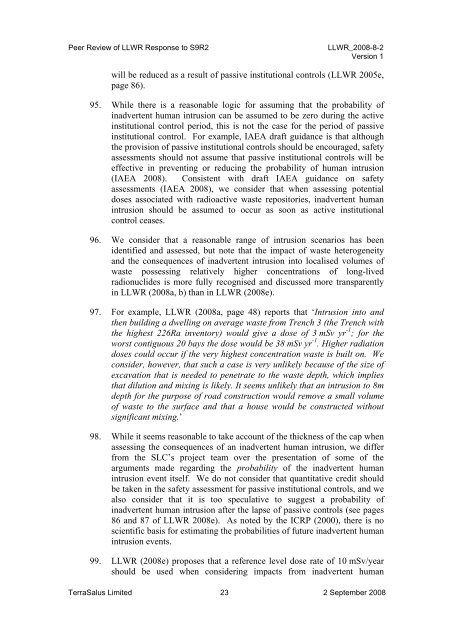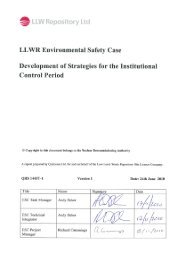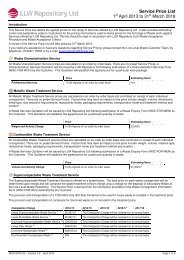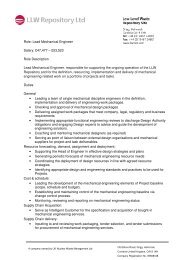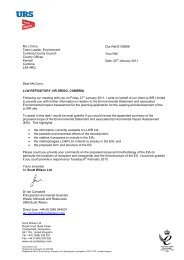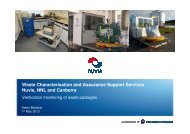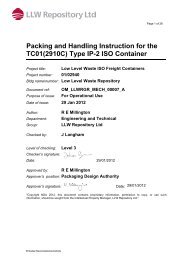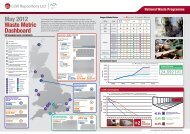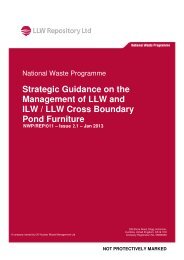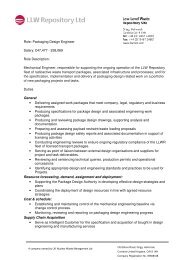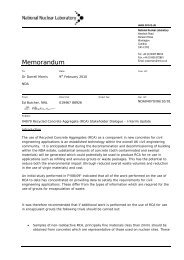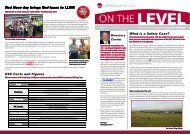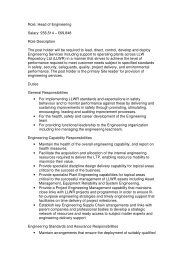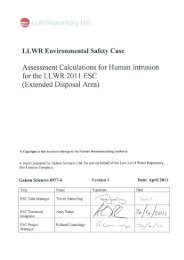Independent Peer Review of - Low Level Waste Repository Ltd
Independent Peer Review of - Low Level Waste Repository Ltd
Independent Peer Review of - Low Level Waste Repository Ltd
Create successful ePaper yourself
Turn your PDF publications into a flip-book with our unique Google optimized e-Paper software.
<strong>Peer</strong> <strong>Review</strong> <strong>of</strong> LLWR Response to S9R2LLWR_2008-8-2Version 1will be reduced as a result <strong>of</strong> passive institutional controls (LLWR 2005e,page 86).95. While there is a reasonable logic for assuming that the probability <strong>of</strong>inadvertent human intrusion can be assumed to be zero during the activeinstitutional control period, this is not the case for the period <strong>of</strong> passiveinstitutional control. For example, IAEA draft guidance is that althoughthe provision <strong>of</strong> passive institutional controls should be encouraged, safetyassessments should not assume that passive institutional controls will beeffective in preventing or reducing the probability <strong>of</strong> human intrusion(IAEA 2008). Consistent with draft IAEA guidance on safetyassessments (IAEA 2008), we consider that when assessing potentialdoses associated with radioactive waste repositories, inadvertent humanintrusion should be assumed to occur as soon as active institutionalcontrol ceases.96. We consider that a reasonable range <strong>of</strong> intrusion scenarios has beenidentified and assessed, but note that the impact <strong>of</strong> waste heterogeneityand the consequences <strong>of</strong> inadvertent intrusion into localised volumes <strong>of</strong>waste possessing relatively higher concentrations <strong>of</strong> long-livedradionuclides is more fully recognised and discussed more transparentlyin LLWR (2008a, b) than in LLWR (2008e).97. For example, LLWR (2008a, page 48) reports that ‘Intrusion into andthen building a dwelling on average waste from Trench 3 (the Trench withthe highest 226Ra inventory) would give a dose <strong>of</strong> 3 mSv yr -1 ; for theworst contiguous 20 bays the dose would be 38 mSv yr -1 . Higher radiationdoses could occur if the very highest concentration waste is built on. Weconsider, however, that such a case is very unlikely because <strong>of</strong> the size <strong>of</strong>excavation that is needed to penetrate to the waste depth, which impliesthat dilution and mixing is likely. It seems unlikely that an intrusion to 8mdepth for the purpose <strong>of</strong> road construction would remove a small volume<strong>of</strong> waste to the surface and that a house would be constructed withoutsignificant mixing.’98. While it seems reasonable to take account <strong>of</strong> the thickness <strong>of</strong> the cap whenassessing the consequences <strong>of</strong> an inadvertent human intrusion, we differfrom the SLC’s project team over the presentation <strong>of</strong> some <strong>of</strong> thearguments made regarding the probability <strong>of</strong> the inadvertent humanintrusion event itself. We do not consider that quantitative credit shouldbe taken in the safety assessment for passive institutional controls, and wealso consider that it is too speculative to suggest a probability <strong>of</strong>inadvertent human intrusion after the lapse <strong>of</strong> passive controls (see pages86 and 87 <strong>of</strong> LLWR 2008e). As noted by the ICRP (2000), there is noscientific basis for estimating the probabilities <strong>of</strong> future inadvertent humanintrusion events.99. LLWR (2008e) proposes that a reference level dose rate <strong>of</strong> 10 mSv/yearshould be used when considering impacts from inadvertent humanTerraSalus Limited 23 2 September 2008


